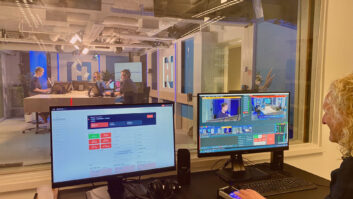
Jim Stagnitto, director of engineering for WNYC, sent this photo of the organization’s AM site in Kearny, N.J., shortly after Sandy left the area. The walkway serves Tower No. 1. I purchased a GE Superadio for my mom and dad about 10 years ago because I wanted them to be able to listen to morning radio in their kitchen.
Mom’s a lifelong WOR listener, a habit she inherited from her own parents while growing up in Brooklyn. So I wanted her to have a good AM receiver. As longtime readers will recall, the GE Superadio was considered among the elite.
My parents’ safety was not part of my thinking when I bought the radio, but it could have been.
They live in northern New Jersey. Like millions of other people they were whacked by Sandy. They were not hurt, for which I am thankful, and their house lost only some shingles. Nevertheless, they had a scary time of it. They were plunged into nighttime darkness. They had no heat. They were cut off from Internet connectivity and TV. They had cell service only as long as their cell batteries lasted.
They steadfastly declined my offers to fetch them, preferring to stay in their home and keep an eye on it. I monitored from a distance and worried about nighttime temperatures.
On Day 2, my mom mentioned that she and Dad felt so out of touch with what was going on in the world. “Why don’t you listen to the radio,” I asked. She replied that her radios didn’t work without power. I reminded her of the one in the kitchen and suggested she put batteries in it.
Their power outage ultimately lasted a week. My folks were not entirely cut off from the world — they had landlines, newspapers and kind neighbors — but during this time, the GE Superadio was an important information pipeline. Were other people in the same situation? Were grocery stores open? Were gas stations open? What was the utility saying about when power would be back? Would the temperature go below freezing at night?
The radio also was an important source of comforting entertainment when TV was unavailable and darkness made reading more difficult.
My parents’ experience is a ringing reminder to me that pronouncements from NAB and others about radio’s role — as a “first informer” and listener friend in times of crisis — are not just PR talking points. They highlight a fundamental truth.
‘One medium that matters’
Others noticed too. The National Journal, citing FCC data, reported that because of power outages and physical damage, as much as 25 percent of cell sites in the storm’s path were flat-out not operating the morning after Sandy. A quarter of broadband, home phone or cable services experienced widespread outages.
Publication AdAge wrote: “Batteries are drained, Internet connections long-gone. For the nearly 5 million households muddling through a fourth day without power in the wake of Hurricane Sandy, there’s really only one medium that matters, and that’s radio.”
Radio received many such reviews (though sometime with a condescending subtext: “Not bad for an otherwise outdated technology.”)
Radio and its regulators would do well to consider the lesson.
As a reader noted on our website: “This is something we’ve known for years in the Gulf Coast region of Texas and Louisiana. No other medium has the solid-built infrastructure of TV and radio. When all the others fail such as satellite, Internet, cellphone and cable, over-the-air broadcasting is still on.”
New Jersey Broadcasters Association President/CEO Paul Rotella was interviewed by Radio World’s Emily Reigart after Sandy:
“You don’t listen to Pandora to find out your weather, your emergency information, where to find food and shelter. Not only don’t you go there, you probably can’t go there, because we’re so dependent on electricity and other infrastructure that’s very weak in nature.” He also reminded us that many in local radio have built particularly strong relationships with the National Guard, law enforcement, EMS and other first responders.
(If you missed it, find Rotella’s interview at radioworld.com/links. He had particularly nice things to say about engineers.)
Simply put, a station’s broadcast infrastructure is more robust than that of many media alternatives. Further, if a given station does goes off the air, others probably did not; we can tune to another station, whereas we can’t just change cell or Internet provider in the middle of a hurricane.
So the next time you hear some industry bigwig hailing radio’s role in emergencies, don’t dismiss the statement as mere lobbying to influence a piece of legislation. It might be that, surely; but it also happens to be true.
To hold up our end of the bargain, radio stations must plan to stay on the air. That attitude needs to come from station management, who must explicitly make continuity of operations a key goal.
Are your engineers or operations managers given that mandate? Do they have authority to carry it out? Have you considered where the “failure points” in your air chain lie? Have you built your facility with redundancy in mind? Do you own generators? Do you exercise them regularly? Is there sufficient fuel for extended operations? Have you created an emergency staff contact list? These are familiar questions to Radio World readers.
(Programmers bear an equal responsibility. At news stations, this is obvious. Music stations: If your community is hit by a crisis but your jocks or automation system are happily doing exactly what they always do, with little or no reference to the situation in which your listeners find themselves, you are not only wasting an opportunity, but you are not upholding your license.)
So. Well done, radio. For myself, I’ll be thinking about my mother’s radio. And I’ll be grateful for it.










